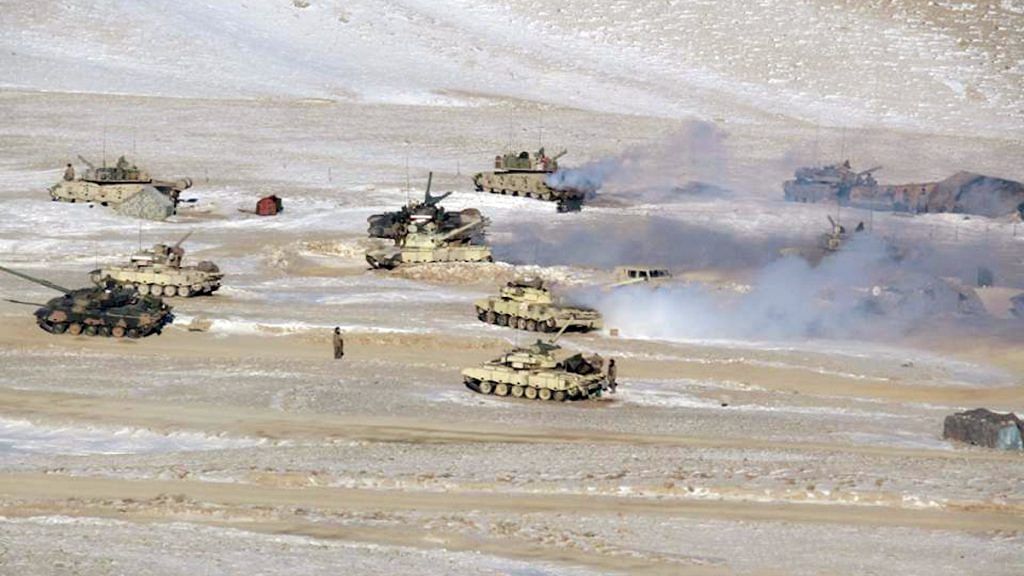New Delhi: India and China failed to make headway in further resolving the 17-month-long standoff in eastern Ladakh during the 13th Corps Commander level talks held Sunday, with People’s Liberation Army (PLA) refusing to disengage from the Hot Springs area, Depsang Plains and Demchok besides overall de-escalation.
The Indian Army said the “Chinese side was not agreeable” and “could not provide any forward-looking proposals”
The Indian side, led by the 14 Corps Commander Lt Gen P.G.K. Menon stuck to its stand during the meeting, which began at 10:30 am and ended at 7 pm at Moldo meeting point on the Chinese side.
A statement released by the Indian Army Monday said during the meeting the discussions between the two sides focused on resolution of the remaining issues along the LAC in eastern Ladakh.
The Indian side pointed out that the situation along the LAC had been caused by unilateral attempts by the Chinese side to alter the status quo and in violation of the bilateral agreements, the statement said.
“It was therefore necessary that the Chinese side take appropriate steps in the remaining areas so as to restore peace and tranquillity along the LAC in the Western Sector,” the Army statement added.
It said that this would also be in accord with the guidance provided by the foreign ministers of the two countries during their recent meeting in Dushanbe where they had agreed that the two sides should resolve the remaining issues at the earliest.
India emphasised that resolution of the remaining areas would facilitate progress in the bilateral relations. “During the meeting, the Indian side therefore made constructive suggestions for resolving the remaining areas but the Chinese side was not agreeable and also could not provide any forward-looking proposals. The meeting thus did not result in resolution of the remaining areas,” the statement said.
It added that the two sides have agreed to maintain communications and also to maintain stability on the ground.
“It is our expectation that the Chinese side will take into account the overall perspective of bilateral relations and will work towards early resolution of the remaining issues while fully abiding by bilateral agreements and protocols,” the Army said.
The military talks were held a day after Army Chief Gen M.M. Naravane said that if “it means that they (PLA) are there to stay, we are there to stay too”.
Gen Naravane had Saturday said it is difficult to understand why China triggered the standoff “but whatever it might have been, I do not think they have been able to achieve any of those because of the rapid response done by the Indian armed forces”.
Also read: India, China should properly handle differences, move towards stability, envoy Sun Weidong says
‘India insisted on unreasonable demands,’ China says
Meanwhile, the spokesperson of the PLA Western Theater Command, in a statement, said, “India still insisted on the unreasonable and unrealistic demands, which made the negotiations more difficult.”
#India still insisted on the unreasonable and unrealistic demands, which made the negotiations more difficult, China's PLA Western Theater Command spokesperson said after the 13th round of the corps commander-level talks between China and India on Sunday. pic.twitter.com/NYHoU5RpwE
— People's Daily, China (@PDChina) October 11, 2021
The spokesperson also said it is hoped that India “will not misjudge the situation, cherish the hard-won situation in the China-India border areas, show sincerity and take actions, and work with China to jointly safeguard peace and stability in the border areas”.
China’s refusal to disengage from Hot Springs is a change in its stand because last year it had agreed to the disengagement plan and pulled back some of its troops. The process, however, was not completed.
Sources in the Indian defence establishment told ThePrint that India is prepared for the worst and will continue to remain forward deployed all along the Line of Actual Control (LAC).
ThePrint was the first to report on 4 October that even if there is a forward movement in Hot Springs area, India and China will continue troop deployment in the forward areas of Ladakh for a second consecutive winter.
Following the 9 hours of 12th Corps Commander level talks held on 31 July, both sides completed disengagement from the Gogra area. This meant that all face-off positions — Northern and southern banks of Pangong Tso, Galwan Valley, Gogra — were completed except the Hot Springs area.
Also read: India says doesn’t believe in ‘clash of civilisations’ but China must end Ladakh conflict
India & China carry out massive troop and infrastructure build up
Since the stand-off began last year, the Chinese have built and continue to build dozens of large weather-proof structures along the LAC for their troops to stay during the winter.
While disengagement happened at several locations, the PLA troops have not gone back to their traditional holding positions and continue to remain close to the LAC.
The Chinese infrastructure includes new helipads, widening of airstrips, new barracks, new surface-to-air missile sites and radar locations.
China has also carried out building new bridges and roads besides housing, to boost its military capability in eastern Ladakh.
India, too, has carried out extensive infrastructure and troop build-up all along the LAC and even carried out changes in its Order of Battle with its “rebalance” from the western borders with Pakistan to the northern borders with China.
Also read: To deal with China on LAC, India must downsize and restructure the armed forces
